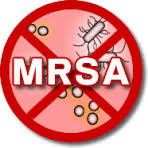 MRSA, commonly called “mer-sa” stands for methicillin resistant Staphylococcus aureus. In my last 2 posts I spoke in detail about Staphylococcus aureus (staph for short): how it goes about wreaking havoc (see here), and examples of the type of havoc wreaked (see here).
MRSA, commonly called “mer-sa” stands for methicillin resistant Staphylococcus aureus. In my last 2 posts I spoke in detail about Staphylococcus aureus (staph for short): how it goes about wreaking havoc (see here), and examples of the type of havoc wreaked (see here).
In the mid 20th century when the antibiotic penicillin was first discovered, staph was completely susceptible to it, meaning that if it was exposed to penicillin, it was killed. The thing is, in this existence, all living things (animals, plants, germs, etc) want to survive, not just us humans. So there is this ongoing fight for survival and in the end, literally only the fittest survive.
Bacteria, in their quest for survival, will adapt in the presence of threats, to ensure that they don’t get eradicated. In this case, the threat is antibiotics. When exposed long enough to antibiotics, bacteria learn smart ways to avoid being killed. Sometimes they change their form making it impossible for a particular antibiotic to penetrate and kill it. Other times, they produce enzymes to inactivate the antibiotic, rendering it ineffective.
Some bacteria are smarter than others and find it easier to escape antibiotics. Staph is one of the smarter ones. Within less than 10 years of the discovery of penicillin, almost half of the staph infecting humans was found to be resistant to penicillin. Scientists therefore developed stronger versions of penicillin, an example being methicillin. However once again, staph outsmarted us and now in many places, more than half of the staph causing serious infections is methicillin resistant, called methicillin resistant Staphylococcus aureus, or MRSA (compared to methicillin sensitive Staphylococcus aureus, or MSSA).
So why is MRSA such a big deal?
It has a lot to do with the treatment of more severe forms of MRSA infection. Here are 3 issues:
1. Treatment is more expensive
2. Treatment often has to be given via a ‘drip’ contributing to the expense and complexity
3. The only effective antibiotics for severe MRSA infection are ‘stronger’ so to speak, with the potential to cause rather harmful adverse effects. Some of these harmful effects include kidney damage which in rare situations can cause the patient to require dialysis (vancomycin, brand name Vancocin), inflamed muscles and a severe allergic pneumonia (daptomycin, brand name Cubicin), damage to nerves, and damage to the bone marrow causing blood cell counts to drop (linezolid, brand name Zyvox).
Fortuntely, a lot of the MRSA infections we see are not too severe and only involve the skin and underlying structures. For these less severe MRSA infections there are several antibiotics available by mouth that are effective, generally less harsh on the body, and certainly less expensive.
In my next post, the last (for now) on staph, I will talk about ways to prevent staph infection.
Leave a Reply